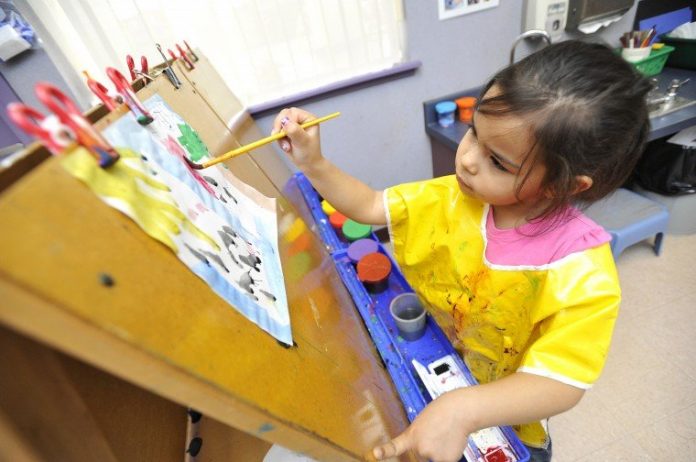“Welcome to the rocket ship,” said 5-year-old Hector Pantoja Jr. Perez, extending his right hand and motioning to a small, red chair with his left.
Donning a NASA costume helmet, Hector takes a seat alongside his co-pilot, Jordan Mungaray, 5.
Classmate Faubritzio Barragan Garcia, 5, joins the expedition. He’s wearing a police hat.
“We need to get gas,” reminds Jordan.
Fostering a love of learning through play is a strategic element of Transitional Kindergarten at Antonio Del Buono Elementary School; one of three schools in Santa Clara County to implement the program this year. All California school districts are required to begin phasing TK in by 2012-13.
Since Antonio Del Buono’s new curriculum commenced in September, its 18 TK students are blossoming, parents are thrilled with their children’s progress and educators are throwing their support behind the program, which broadens the kindergarten experience by spreading it out over two years.
“The program is hands-on, and I like that. That’s how they learn more. They should have this in every school,” said Christina Lazaro, who noticed her twin sons’ English improved rapidly in just two months. Prior to that, the siblings spoke mostly Spanish, she said.
For Antonio Del Buono parents like Lazaro – who said she would seize the opportunity to enroll her 2-year-old daughter in TK when the time comes – the opportunity may never arrive.
In his budget released Jan. 5, Gov. Jerry Brown proposed to permanently eliminate TK funding by the 2012-13 academic year; a move that would save California $223.7 million in 2012-13, and $672 million at full implementation in 2014-15.
“This is a time for reinvestment and reform, not for program expansions,” said Brown in his budget. “As such, (the budget) does not fund the new Transitional Kindergarten program … savings will be used to support existing education programs.”
The proposal reflects an unattractive trend, according to Allan Garde, director of GUSD Fiscal Services. The state has bitten more out of education than any other segment in the last five years – $35 billion – to help resolve its budget crisis.
The creation of TK came hand-in-hand with the Sept. 30, 2010 passage of the Kindergarten Readiness Act of 2010 (Senate Bill 1381), which was introduced by state Sen. Joe Simitian (D-Palo Alto) and signed by then Gov. Arnold Schwarzenegger.
Prior to the passage of SB 1381, a child was required to turn 5 years old by Dec. 2 in order to enroll in kindergarten.
The bill upped the cutoff birthdate for kindergarten eligibility, rolling out the change over a period of three years.
Now, students must turn 5 by Nov. 1, 2012; followed by Oct. 1 in 2013 and Sept. 1 in 2014 to enroll in kindergarten.
For the “young 5s” (i.e., children turning 5 between Sept. 2 and Nov. 1 in 2012) who are too young to enroll, the bill includes a state-funded, transitional kindergarten. The program is designed to be an ancillary bridge between preschool and kindergarten.
Casually coined “Preppy K” by some, TK is one of copious potential casualties endangered by California’s behemoth $9.2 billion budget deficit, which poses looming threats to education and health and human services.
Several campaigns to save TK are under way, including one from Preschool California, an advocacy group which calls kindergarten cutbacks a “lose-lose-lose-lose” for California’s children, parents, teachers and schools.
With 125,000 of the state’s youngest children being “kicked” out of school next year, “62 percent are from low-income schools, and 40 percent are English learners,” according to the organization’s website.
Veteran Gilroy kindergarten teacher Janet Londgren, 58, who was specially trained to spearhead a pilot TK class at Antonio Del Buono this year, finds the news disheartening. She said 12 of her 18 students are English language learners.
“I feel passionately about this program. I was very disappointed when I heard the governor’s proposal,” she said Tuesday, walking back into the classroom clutching a handful of leaves collected for an art project.
After one year of TK, which focuses on emotional, social and behavioral development through hands-on learning and playful activities, students continue to a year of traditional kindergarten, which places a heavier emphasis on academics.
Giving children a chance to get their feet wet – a “bonus year to feel good about school,” as Londgren put it – is exactly what Antonio Del Buono parents like.
“When he first went to pre-school he was really shy, but his vocabulary has gotten much better,” said Anna Garcia, 28, whose son, Devin Ortez, 5, is enrolled in Londgren’s class.
Prior to Devin attending TK, “he wouldn’t talk to anybody,” continued Garcia. “I’ve definitely seen a difference. He’s doing really good. I’m really surprised.”
Similarly, Antonio Del Buono parent and classroom volunteer Melissa Vernon couldn’t be happier with the experience her son, Evan Vernon, is gaining.
“On the first day of school, I thought, ‘(Londgren’s) never going to get these kids to sit down, listen, participate, want to share or be nice to one another,” said Vernon. “It’s amazing the transition they’ve made … this program has been great for them. It makes me really sad that they’re suspending it.”
Interacting with her students Wednesday, Londgren weaves TK curricula into teacher/student dialogue. Part of the program’s concept is aimed at prompting students to engage in active discussion, deal with emotions and solve problems.
“And where did your rocket take you, Hector?” Londgren asked Perez, who chattered away about his imaginary space odyssey.
“To the grocery store,” he replied, after considering the question.
Instead of dictating directions, Londgren approaches every scenario as an opportunity to use the thought process.
“Garbage, or recycling?” she asked Annamarie Medina, 5.
“Garbage,” said Annamarie.
Londgren paused, but didn’t blurt the correct answer.
Annamarie thought it over, glancing at the scraps of purple paper in her hands.
“Recycling,” she said, after reconsidering.
Next year, roughly 125,000 California students in Annamarie’s age bracket could be displaced – particularly those whose parents can’t afford another year of preschool or daycare – if state funding gets yanked from TK.
Right now, GUSD has about 30 children in the “young 5s” bracket who will not be eligible to enroll in kindergarten next year, according to GUSD enrollment secretary Elizabeth Barron. This does not account, however, for any children who are currently not enrolled in GUSD’s preschool.
Lisa Kaufman, director of the Early Learning Services Department for the Santa Clara County Offices of Education, explained legislative action would be needed to change SB 1381.
“That’s where the big questions come into place,” said Kaufman, who worked with GUSD to help launch TK. “There’s a law that says districts needs to provide (TK), and yet there’s the governor’s proposal.”
While the state will have to address this Catch 22, California districts are left to navigate the period of ambivalence in the interim.
GUSD Superintendent Debbie Flores said parents interested in TK can complete a form when registration opens March 3, just in case funding is available to keep the program running.
GUSD was planning to expand the TK program by offering it at several sites within the district, according to Flores. She said a TK teacher would be paid around $60,000, so it would take a ballpark of $180,000 annually to make that happen at three separate school sites.
Until then, the future of the program is stuck in time-out.
GUSD will have a better understanding of what could happen when the governor’s May revision of the budget is released; although Flores said nothing is absolute until the budget is actually passed in June or early July.
The concept of giving 4-year-olds a chance to further develop emotionally and socially prior to entering the first grade isn’t a novelty in GUSD. Gene Sakahara, former principal and teacher at Rod Kelley Elementary School, added a TK program when the school was established in 1987. It eventually ended after eight years due to funding shortages and complications with the fact Rod Kelley was a year-round school at the time.
Annamarie Medina’s mother, Georgina Medina, 31, underscored the importance of giving small students a chance to grow socially and emotionally before they’re placed in an academic environment.
“I wanted her to enjoy (school),” said Medina, who opted to enroll Annamarie in TK this year. “I want her to experience that.”
She praised the hands-on, learning-through-play emphasized in TK; something today’s kindergarten classes have shifted away from.
“That’s the piece that’s not huge in kindergarten anymore,” echoed Londgren. “(TK) helps kids learn how to deal with emotions and solve problems.”
– Gov. Jerry Brown has proposed to permanently eliminate fundingfor a brand-new program called transitional kindergarten (TK).
– This would save California $223.7 million in 2012-13, and $672million in 2014-15.
– There are 18 students in the TK pilot program at Antonio DelBuono; one of three schools in Santa Clara County to implement TKin 2011 before it’s officially required in 2012.
– A rollback to be implemented over three years would movekindergarten enrollment eligibility to 5 years old by Nov. 1 in2012, followed by Oct. 1 in 2013 and Sept. 1 in 2014.
– For the “young 5s” (i.e., children turning 5 between Sept. 2and Dec. 2 in 2012), the bill includes a state-funded, transitionalkindergarten (TK). The program is designed to be an ancillarybridge between preschool and kindergarten.














